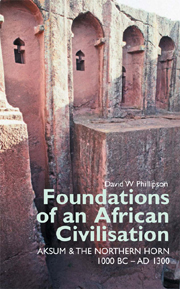Book contents
- Frontmatter
- Contents
- List of illustrations
- 1 General introduction
- Part One BEFORE AKSUM
- Part Two THE KINGDOM OF AKSUM
- 4 Aksumite civilisation: an introductory summary
- 5 Aksumite languages and literacy
- 6 Some written sources relating to Aksumite civilisation
- 7 The emergence and expansion of the Aksumite state
- 8 Aksumite kingship and politics
- 9 Aksumite religion
- 10 Cultivation and herding, food and drink
- 11 Urbanism, architecture and non-funerary monuments
- 12 Aksumite burials
- 13 Aksumite technology and material culture
- 14 Aksumite coinage
- 15 Foreign contacts of the Aksumite state
- 16 Decline and transformation of the Aksumite state
- Part Three AFTER AKSUM
- Bibliographic references
- Index
- EASTERN AFRICAN STUDIES
7 - The emergence and expansion of the Aksumite state
from Part Two - THE KINGDOM OF AKSUM
Published online by Cambridge University Press: 05 December 2015
- Frontmatter
- Contents
- List of illustrations
- 1 General introduction
- Part One BEFORE AKSUM
- Part Two THE KINGDOM OF AKSUM
- 4 Aksumite civilisation: an introductory summary
- 5 Aksumite languages and literacy
- 6 Some written sources relating to Aksumite civilisation
- 7 The emergence and expansion of the Aksumite state
- 8 Aksumite kingship and politics
- 9 Aksumite religion
- 10 Cultivation and herding, food and drink
- 11 Urbanism, architecture and non-funerary monuments
- 12 Aksumite burials
- 13 Aksumite technology and material culture
- 14 Aksumite coinage
- 15 Foreign contacts of the Aksumite state
- 16 Decline and transformation of the Aksumite state
- Part Three AFTER AKSUM
- Bibliographic references
- Index
- EASTERN AFRICAN STUDIES
Summary
Definitions and chronology
The emergence of Aksumite civilisation was a gradual process, not necessarily concomitant with the extension of Aksum's political hegemony. As was shown in Chapter 3, many of its characteristics can be traced back into the period between the fourth and the second/first centuries BC at Beta Giyorgis. However, even there, no sharply defining initial stage may be recognised. Based primarily on artefact typology revealed in their important excavations, Rodolfo Fattovich and Kathryn Bard placed the onset of Aksumite civilisation c. 400–350 BC, at the start of their ‘Proto-Aksumite’ period. That interpretation is not followed in this book, partly because of the conceptual difficulty of incorporating a strongly localised entity within one of hugely greater extent. Instead, the defining stage is seen as concomitant with a shift in the focus of settlement from Beta Giyorgis to the lower and less circumscribed area between that hill and Mai Qoho (see Fig. 19). There, in an area that had apparently seen little previous settlement, rapidly developed the conurbation that ever since has been known as Aksum.
The time at which these developments took place cannot yet be estimated with any precision. On Beta Giyorgis, the excavators have defined the transition from their ‘Proto-Aksumite’ phase to their ‘Early Aksumite’ primarily on the basis of ceramic typology, and its date is not fully clear. The estimate of 150 BC originally published has been replaced by one of 50 BC, but in neither case has its basis or justification been clearly set out.
- Type
- Chapter
- Information
- Foundations of an African CivilisationAksum and the northern Horn, 1000 BC - AD 1300, pp. 69 - 78Publisher: Boydell & BrewerPrint publication year: 2012



